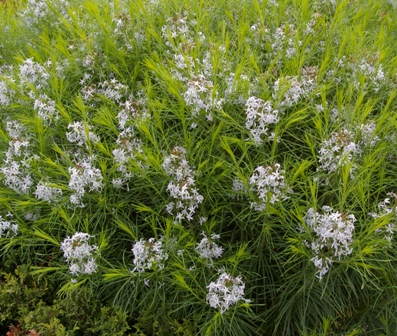Over the decades, I have enjoyed watching the ups and downs of clematis cultivars on the international best-seller list and, on a more modest scale, at our nursery, Joy Creek Nursery. With so many new cultivars being released annually to distract the public, I am always amazed that the tried and true names like ‘Nelly Moser’, ‘Henryi’ and ‘Jackmanii’ continue to hold a fair share of the market even though in human years they are well past retirement.
It was with great surprise last year that a plant that had been on the market for at least 20 years in the United States suddenly became a nursery best-seller. Out of the blue, one day, we began to receive orders from customers who had read an article in Garden Gate magazine about Clematis PINK CHAMPAGNE, originally named ‘Kakio’. The orders came in briskly and surpassed the orders of all other clematis in our catalogue last spring. What was most surprising was that Clematis ‘Asao’, the sister of PINK CHAMPAGNE and usually a better seller, did not sell well at all.
Both plants are the results of a cross done by the Japanese hybridizer Kazushige Ozawa between (what we think was) Clematis ‘Ernest Markham’ and Clematis ‘Crimson King’. There were three seedlings that were released from this cross but only the two sisters remain. ‘Asao’ and ‘Kakio’ are very similar in appearance with bright rose red flowers in April. As the flowers of both cultivars  age, they become lighter at the bases and centers of their sepals. ‘Asao’ is usually the first of all our large-flowered clematis to bloom at the nursery in the spring followed soon after by ‘Kakio’. (By the way, the names refer to actual small towns in Kawasaki near the hybridizer’s home. Raymond Evison, the well-known English hybridizer and nurseryman, visited Japan in 1984 and received ‘Kakio’ from Mr. Ozawa. He renamed it PINK CHAMPAGNE for marketing purposes.) It is interesting that even though the two plants are close in appearance, Mr. Ozawa chose to release both instead of choosing one over the other. Why is that?
age, they become lighter at the bases and centers of their sepals. ‘Asao’ is usually the first of all our large-flowered clematis to bloom at the nursery in the spring followed soon after by ‘Kakio’. (By the way, the names refer to actual small towns in Kawasaki near the hybridizer’s home. Raymond Evison, the well-known English hybridizer and nurseryman, visited Japan in 1984 and received ‘Kakio’ from Mr. Ozawa. He renamed it PINK CHAMPAGNE for marketing purposes.) It is interesting that even though the two plants are close in appearance, Mr. Ozawa chose to release both instead of choosing one over the other. Why is that?
I think it is because he had come to love both of them and thought they were different enough in character to warrant release. ‘Asao’ is the more star-shaped of the two. She is also the flashiest in appearance with flowers that show extra sepals. Sometimes this results in flowers that are semi-double or even completely double. ‘Kakio’ has what appears to me to be an underlayment of lavender on its more rounded sepals. This underlayment gives the flowers a smoky appearance. I have never seen ‘Kakio’ double. Neither sister produces much fall bloom although they sometimes manage a lovely stray flower or two. It is the stunning spring bloom that is so memorable. It is long and unforgettable enough to make a gardener anxious for spring to see the familiar flowers again.
Over the years Mr. Ozawa gave up growing and selling both plants. He said that the temperature index in the Tokyo area had gone up so much since the plants were released that they no longer retained their crisp colors when they bloomed. He told me that both were more suited to areas with cooler spring temperatures. I remember a visit he made to our nursery when ‘Asao’ was in bloom. He was delighted to see the flowers looking the way he remembered.
I have no idea what clematis will become the most sought after this coming year. But if you want one or two reliable and remarkably beautiful spring flowering clematis, either or both of these “new” classics will do.
Maurice Horn










Lovely article, Maurice. Beautiful descriptions.
LikeLike
Pink Champagne was the very first Clematis to bloom in my first garden (I believe it was 20 years ago in ’92). It holds a special place in my heart even though I no longer grow it.
LikeLike
Pink Champagne is one of my favorites and is usually the first to bloom in my garden. My Josephine, another favorite, was lovely and large for many years, but the last 2 years has died out. Do clematis have a lifespan or did I not treat it right? Thank you for any information on this.
LikeLike
My guess is that something changed in the area surrounding the plant that caused it to lose vigor. Were the roots eaten by a vole? Did it become over saturated in the winter? Was the plant getting fertilized? Sometimes a lack of nutrition in the soil can lead to a plants decline. These are all just guesses, I will ask around to see if anyone has other ideas.
LikeLike
Thank you, maybe it needs more fertilizer, no voles and we do not have Portland weather, so not water logged. I have lots of clematis, but lose some every year. Clematis, for me, is a very unpredictable plant, but I love them and I have many. I have been to your garden once and hope to visit again. Dot
LikeLike